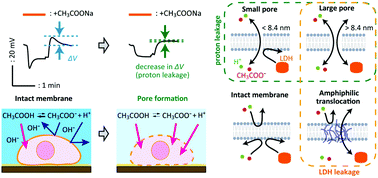A proton/macromolecule-sensing approach distinguishes changes in biological membrane permeability during polymer/lipid-based nucleic acid delivery†
Abstract
Endosomal escape is crucial for the delivery of nucleic acids. However, the understanding of the underlying mechanisms is still deficient. In this work, we explored the effects of lipid- and polymer-based transfection reagents on the permeability of cellular membranes through an innovative method combining a proton-sensing transistor and a cytosolic LDH leakage assay, which allows us to distinguish between modes of molecule permeation that may occur during endosomal escape. By testing the commercial reagents lipofectin and in vivo JetPEI under physiological and endosomal pH conditions, we found that both lipid- and polymer-based transfection reagents have pH-dependent pore-forming activity, with the former creating smaller pores than the latter. This versatile approach of assessing carrier–membrane interactions is expected to contribute to the development of next-generation nucleic acid delivery systems.

- This article is part of the themed collection: Journal of Materials Chemistry B Lunar New Year collection 2022


 Please wait while we load your content...
Please wait while we load your content...